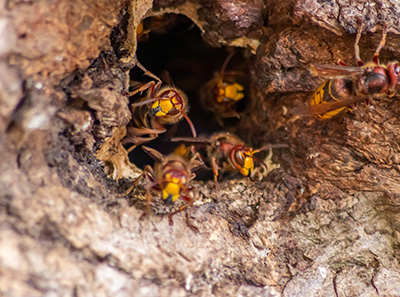It’s never pleasant to come across wasps and yellow jackets. Their stings are painful, and some individuals may even have a severe allergic reaction to being stung. In addition, they can cause property damage if an infestation is left untreated. If you notice any signs of an infestation, the best course of action is to call a professional who will be able to correct the problem safely and effectively.
Wasp Control in PA
When it comes to diagnosing a pest infestation, it is important to note the differences between species of stinging insects. Although different varieties of stinging insects may look very similar, stinging insect control measures vary across species.
Paper wasps are typically around one inch long, with the smallest measuring at half an inch and the largest as long as one and a half inches. Their bodies are a dark shade of red, reddish brown or yellow. They prefer to make their nests in areas that are exposed yet difficult to reach, such as the corners of windows, the undersides of porches and decks, or within attics if they are able to find a point of entry.
You’ll know that the uninvited guests on your property are paper wasps if you spot a nest that looks like an umbrella. It will be attached to a surface with a long, thin stalk and have a round shape that flares outwards. The size of any wasp colony can vary widely: while the majority are limited to a few dozen members, some could have as many as one hundred. If the wasps register a disturbance to their newfound home, they will attack, so you should call a professional to help get rid of them rather than attempting to do so on your own. Our technicians will knock down the wasp nest and use a powerful treatment product to deter any future activity.

Yellow Jacket Control in PA
Although most people tend to think of bees and wasps as different insects and of yellow jackets as a type of bee, yellow jackets are actually a type of wasp: all yellow jackets are wasps, but not all wasps are yellow jackets. You can identify yellow jackets by their size (between three eighths and five eighths of an inch) and their abdomens (smooth and hairless, with yellow and black stripes). They often build their nests underground, so it’s all too easy to accidentally disturb them by mowing your lawn, performing other landscaping work or simply stepping on the wrong spot. If you notice insects fitting this description flying in and out of a hole in the ground, make sure to stay a safe distance away from the area.
If you notice yellow jackets on your property, you should plan to enlist a stinging insect control professional as soon as possible, since they can be dangerous. Contrary to popular belief, yellow jackets have the ability to sting more than once. Their stings are painful and may pose a significant safety risk, especially to small children and people who are allergic. A stinging insect infestation will make it more difficult for you and your family to enjoy your home, and if you are a business owner, seeing them is sure to be a turn-off to customers.
How Seitz Bros. Can Help
Although there are sprays and other products available over the counter to help combat a wasp or yellow jacket infestation, the best course of action is always to call a professional. Some species of stinging insects are more aggressive than others, and attempting to destroy a nest on your own is very risky. Plus, as with any infestation, the longer a wasp or yellow jacket colony is left alone, the larger and more powerful it will become (and the more difficult it will be to rectify the situation).
Seitz Bros. technicians are well versed in helping to get rid of all types of pests, including stinging insects, and we are prepared to work around your schedule. We will do a site visit and provide an estimate free of charge, and we are able to serve homes and businesses throughout northeastern and central Pennsylvania. If you suspect that you may have an infestation, contact us today!
Wasp & Yellow Jacket Control Pest Control in Pennsylvania & New Jersey
Serving Northeast & Central PA | Lehigh Valley | Pocono Mountains | Western NJ
